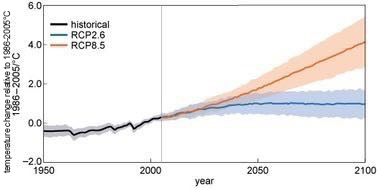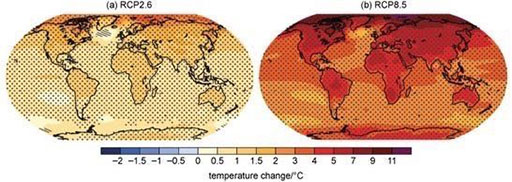3.1 Global warming
Figure 4 shows the IPCC (2013) predictions for annual mean GMST change for the lowest and highest greenhouse gas concentration pathways, RCP2.6 and RCP8.5.

-
What do you notice about the predictions during the first few decades of the twenty-first century?
-
They are quite similar for the two different RCP scenarios (the shaded bands overlap a lot).
Temperature changes up to 6 °C may not seem much, but estimates of GMST at the end of the century is predicted to be as much above the GMST before the industrial revolution as the ice age was below it.
Compare these predictions with those in the maps in Figure 5.

-
Comparing Figures 4 and 5, what important extra information does the full map (Figure 5) provide compared with the global mean (Figure 4)?
-
Regional variations. The global mean cannot show the fact that warming is predicted to be greater over land (i.e. where humans live) than the oceans, and that regional changes are predicted to be larger than the global mean in many places. For example, more than 10 °C warming is predicted in the Arctic for RCP8.5, while the global average is around 4 °C warming.
In terms of temperature extremes, the IPCC (2013) predicts that it is ‘virtually certain’ that hot days and nights will become warmer and/or more frequent, and that cold days will become warmer and/or less frequent by the end of the twenty-first century – for all four RCPs.
